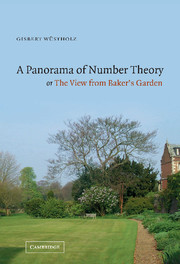Book contents
- Frontmatter
- Contents
- Contributors
- Introduction
- 1 One Century of Logarithmic Forms
- 2 Report on p-adic Logarithmic Forms
- 3 Recent Progress on Linear Forms in Elliptic Logarithms
- 4 Solving Diophantine Equations by Baker's Theory
- 5 Baker's Method and Modular Curves
- 6 Application of the André–Oort Conjecture to some Questions in Transcendence
- 7 Regular Dessins, Endomorphisms of Jacobians, and Transcendence
- 8 Maass Cusp Forms with Integer Coefficients
- 9 Modular Forms, Elliptic Curves and the ABC-Conjecture
- 10 On the Algebraic Independence of Numbers
- 11 Ideal Lattices
- 12 Integral Points and Mordell–Weil Lattices
- 13 Forty Years of Effective Results in Diophantine Theory
- 14 Points on Subvarieties of Tori
- 15 A New Application of Diophantine Approximations
- 16 Search Bounds for Diophantine Equations
- 17 Regular Systems, Ubiquity and Diophantine Approximation
- 18 Diophantine Approximation, Lattices and Flows on Homogeneous Spaces
- 19 On Linear Ternary Equations with Prime Variables – Baker's Constant and Vinogradov's Bound
- 20 Powers in Arithmetic Progression
- 21 On the Greatest Common Divisor of Two Univariate Polynomials, I
- 22 Heilbronn's Exponential Sum and Transcendence Theory
2 - Report on p-adic Logarithmic Forms
Published online by Cambridge University Press: 20 August 2009
- Frontmatter
- Contents
- Contributors
- Introduction
- 1 One Century of Logarithmic Forms
- 2 Report on p-adic Logarithmic Forms
- 3 Recent Progress on Linear Forms in Elliptic Logarithms
- 4 Solving Diophantine Equations by Baker's Theory
- 5 Baker's Method and Modular Curves
- 6 Application of the André–Oort Conjecture to some Questions in Transcendence
- 7 Regular Dessins, Endomorphisms of Jacobians, and Transcendence
- 8 Maass Cusp Forms with Integer Coefficients
- 9 Modular Forms, Elliptic Curves and the ABC-Conjecture
- 10 On the Algebraic Independence of Numbers
- 11 Ideal Lattices
- 12 Integral Points and Mordell–Weil Lattices
- 13 Forty Years of Effective Results in Diophantine Theory
- 14 Points on Subvarieties of Tori
- 15 A New Application of Diophantine Approximations
- 16 Search Bounds for Diophantine Equations
- 17 Regular Systems, Ubiquity and Diophantine Approximation
- 18 Diophantine Approximation, Lattices and Flows on Homogeneous Spaces
- 19 On Linear Ternary Equations with Prime Variables – Baker's Constant and Vinogradov's Bound
- 20 Powers in Arithmetic Progression
- 21 On the Greatest Common Divisor of Two Univariate Polynomials, I
- 22 Heilbronn's Exponential Sum and Transcendence Theory
Summary
Historical introduction
The p-adic theory of logarithmic forms has a long history, following closely the results in the complex domain; and it has been applied to Leopoldt's conjecture on p-adic regulators (for abelian extensions of Q, see Ax 1965 and Brumer 1967), to polynomial and exponential Diophantine equations, to the problem of the greatest prime divisors of polynomials or binary forms, to linear recurrence sequences (see Shorey & Tijdeman 1986), to knot theory (see Riley 1990) and to the abc-conjecture (see Stewart & Tijdeman 1986, Stewart & Yu 1991, 2001), etc. The present report will emphasize the evolution of the theory of p-adic logarithmic forms and its application to the abc-conjecture.
Mahler (1932) proved the p-adic analogue of the Hermite–Lindemann theorem. In 1935, he obtained a p-adic analogue of the Gel'fond–Schneider Theorem. During the course of this work, he founded the p-adic theory of analytic functions.
Gel'fond (1940) proved a quantitative result on linear forms in two p-adic logarithms in analogy with his classic work on Hilbert's seventh problem relating to two complex logarithms. Schinzel (1967) refined Gel'fond's results, giving completely explicit bounds.
At the end of his 1952 book, Gel'fond wrote ‘Nontrivial lower bounds for linear forms, with integral coefficients, of an arbitrary number of logarithms of algebraic numbers, obtained effectively by methods of the theory of transcendental numbers, will be of extraordinarily great significance in the solution of very difficult problems of modern number theory.’
- Type
- Chapter
- Information
- Publisher: Cambridge University PressPrint publication year: 2002
- 5
- Cited by



